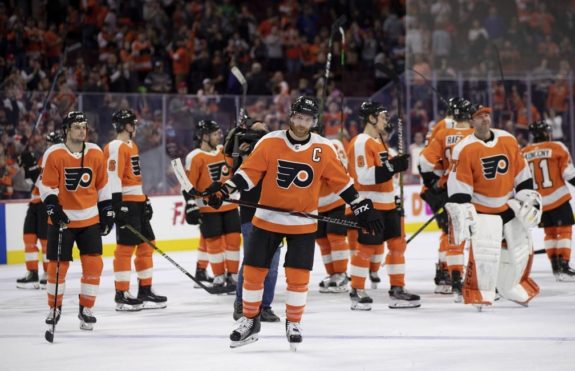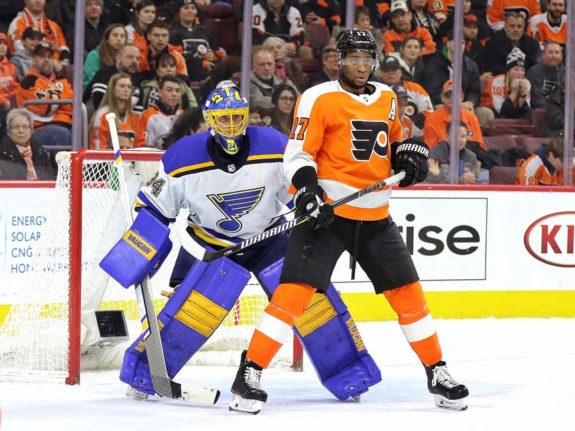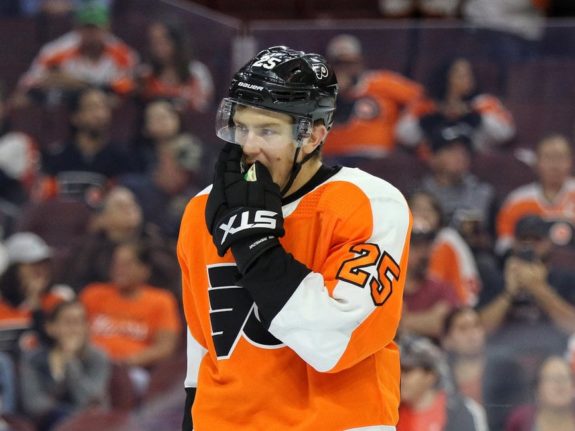“The Flyers are going on the PECO power play!”
Hearing those words used to excite me greatly, but as of late, seeing the Philadelphia Flyers go on the power play barely draws any enthusiasm from me at all. And I’m not the only one that feels this way.
After watching the Flyers fail to produce on their first two power plays of the game against the Capitals on Sunday, fans groaned and took to Twitter to express their frustrations when the team was given a four-minute man-advantage, early in the third period, as a result of a Zdeno Chara high-stick.
They would muster only one shot on that four-minute power play, never getting themselves set up, and spending the majority of their ‘advantage’ outside of the offensive zone.
The Flyers power play has been downright bad, and it has been for quite a while now. If they’re to be serious contenders come playoff time, they’ll need to find a solution, and soon.
Departures Have Hurt the Flyers’ Power play
The power play hasn’t always been an issue for the Flyers. In fact, it used to be one of their strong suits. For the better part of a decade, the Flyers’ PP was something to be feared around the league.
Between the 2011-12 and 2016-17 seasons, the Flyers’ power play ranked near the top of the NHL, with a top-three rate of conversion in both over that span. While there were legitimate criticisms at the time, namely that the second unit struggled to convert, the overall production was strong.

Claude Giroux and Jakub Voracek, the two top special teams point-scorers from when the Flyers’ power play was at its peak, are both still around. In addition to those two; Sean Couturier has blossomed into a weapon at both ends of the ice, new faces such as Travis Konecny, Ivan Provorov, and Shayne Gostisbehere have emerged, and the ever-dangerous net-front presence in James Van Riemsdyk has returned to Philadelphia. With so many offensive weapons at their disposal, there should be a threat to score every time their opponents take a penalty, but that just hasn’t been the case. So why have things gone sour?
Production took a dip when long-time assistant coach and power play runner, Joe Mullen was relieved of his duties. Under Mullen, the Flyers more often than not had one of the better power plays in the league, and since his departure, they’ve had difficulty getting consistent production out of their man-advantage. His system utilized constant player and puck movement, emphasizing getting traffic to the front of the net, so when they got their shots off, the opposing goalie wouldn’t have an easy time tracking the puck.
Mullen was replaced as PP coach by Kris Knoblauch, a fresh face who had seen success in the OHL with the Erie Otters. With Knoblauch at the helm, the power play slipped from 14th in the league to 16th, before dipping further to 23rd the following season. Replacing him in late 2019 was current assistant coach, Michel Therien who guided the Flyers back to the top half of the league in his first season with them. But come playoff time, the unit began to struggle again, struggles that have carried over to the current season.
While the departure of Mullen dealt a blow to the Flyers’, he wasn’t the only significant departure. Wayne Simmonds was a major enabler of Mullen’s system, parking himself in front of the net, searching for rebounds, and making key deflections. As a Flyer, Simmonds consistently generated high-danger scoring chances (HDSC) when on the ice with the man-advantage.

Between 2013 and 2015, when the Flyers power play was at its best in terms of production, Simmonds led the NHL in individual HDSC on the PP with a whopping 157, nearly doubling the HDSC of the next highest ranking Flyer. With his high-danger chances came power-play goals (PPG) in droves. In his time with the team, he was consistently near the top of the league in PPG, scoring 10 or more in six separate seasons. His presence was paramount for the Flyers and the man-advantage hasn’t quite been the same since his departure.
An Early Season of Ups and Downs
The Flyers’ power play seemed to be off to a solid start, lighting the lamp seven times on 24 chances through the first seven games of the season. Four of those tallies came from JVR, who has been a major bright-spot so far. Scoring on 29.1% of their power plays left fans optimistic, but the team has fallen back down to earth since then.
The next stretch of games, including the recent and high-scoring affair against the Capitals, has seen the Flyers score only twice on 18 attempts for an abysmal 11.1% rate of conversion on the man-advantage. This places them in the league’s basement over that span of games.

At this point, a strong start followed by a poor stretch of games has the Flyers sitting at the middle of the league table in power-play percentage (PP%) so far this season. The team currently has the 14th best PP% in the NHL with a 21.4% rate of conversion.
Outside of van Riemsdyk, the Flyers haven’t looked especially threatening with the man-advantage this season. Despite this, they have the potential to turn things around. With their plethora of offensive weapons, proven power-play scorers in Giroux and Voracek, and young players settling in, the Flyers just need to find the right formula. But they need to find it sooner, rather than later.